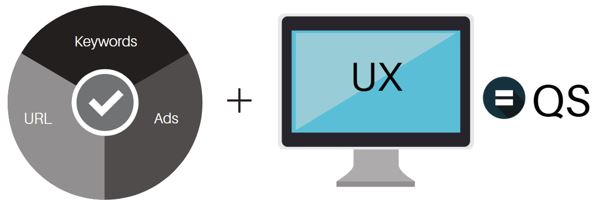What Is Quality Score, And Why Is It Important?
Quality Score is a PPC related metric used in Google Ads to determine the performance of your advertisements.
Google’s Quality Score algorithm is a combination of two elements, the user experience (UX) and the relevance of your ad. Ad relevance could seem an abstract concept, but it reflects the relevance of your ad copy, the keyword, and the URL to the search term a user is looking for. In simple words, the Quality Score evaluates to what level your ad corresponds to the user’s needs.

However, although these are the main elements of the Quality Score algorithm, they are not the only ones. This blog post presents the factors that influence Quality Score, the benefits that a higher QS can bring to your PPC account, as well as how to increase your Quality Score to be more competitive amongst other advertisers.
What determines the Quality Score?
Google’s Quality Score is reported on a scale from 1 to 10, and is determined based on:
- Your PPC landing page quality and relevance to the keyword you are bidding on.
- The relevancy of your ad copy to the keyword.
- The expected click-through rate of your keyword compared to the other competitors bidding on that keyword.
However, Google has not shared the importance of each component within the Quality Score algorithm.
How to check your Quality Score?
In your Google Ads account Quality Score section, you add and can view four components on your statistics table:
- Qual. Score
- Landing page experience
- Ad relevance
- Expected CTR
You will then be able to see the last known Quality Score for a specific reporting period, as well as daily ones and daily scores for your ad and landing page relevance and usefulness to your potential customers. You can also view your daily expected click-through rate.
As previously explained, QS is evaluated from 1-10, but for ad and landing page relevancy you can expect to see statuses such as “Below average”, “Above average”, and “Average”.
How can you improve your Quality Score?
There are several strategies you can use to improve your Quality Score:
- Keyword research
- Keyword organisation in ad groups
- Optimising ad copy
- Creating and optimising PPC landing pages
- Creating a negative keyword list
Keyword research, grouping, and negative keywords
Your PPC ads should respond to the user’s search intent, therefore write the copy for the user. When a user searches for a term, if it is related to the keywords you are bidding on and including in your ad copies, then Google might show the ad to the user.
Create a negative keyword list to exclude irrelevant keywords you do not wish to rank for. This way, you will be spending your budget only on potential high-quality leads.
For example, you could create an ad group for maxi dresses that contains all your maxi dress keywords and another ad group for bodycon dresses that includes all your bodycon keywords. This way the ad copy for your bodycon dresses adgroup can mention bodycon dresses and the ad copy for your maxi dresses adgroup can mention maxi dresses. If you find that your keywords have enough volume, then you could segment your keywords further by creating more granular ad groups and then tailoring your adcopy even more to those granular adgroups.
For example, if you find that maxi dresses have a lot of volumes and you see a lot of volume for sizes. Then you could have an ad group for each size. For example, you’d have an ad group for size eight bodycon dresses and another ad group for size ten bodycon dresses, which will allow you to make the ad copy a lot more tailored to the search term.
Landing page experience
Landing page experience is one of the many factors that impact Quality Score. With that in mind, firstly, evaluate if your landing page content is unique both in comparison to other landing pages on your site and to third party websites.
Secondly, make sure your site architecture and navigation are easy to understand, and users can find information or products and services they are looking for with ease. Optimise your page speed and make sure the site is friendly to crawlers too.
Lastly, use your keyword research to have a keyword optimised landing page copy and ad copy.
What are the benefits of a higher Quality Score?
A higher Quality Score means that your PPC ad will receive a higher ad ranking position in the Google search results, and you will be charged less for a PPC ad click. A higher ad rank means that you will get more for your money with Google Ads. This could result in a higher position on the page without paying more for a click. Or if you already appear on position one and have a 100% impression share, it could mean lower click prices.
There is also a correlation between the PPC cost per conversion and the Quality Score. The higher your Quality Score, the lower will be the cost of each conversion. This is because a higher Quality Score can results in lower click prices on Google Ads. A conversion is whatever you have set it out to be, for example, a user subscribing to your newsletter, downloading an e-book, or filling out a contact form.
Having a low-Quality Score can be very expensive. Google’s QS benchmark is 5/10, and a Quality Score of 1/10 means a 400% higher cost per click than the benchmark would be.
To see how Quality Score matters in the Google Ads auction, read our ultimate PPC guide or click here to find out more about Pepper PPC Agency.